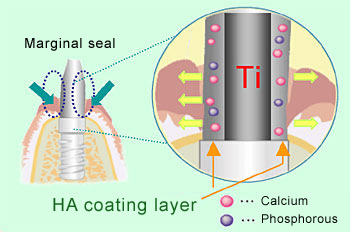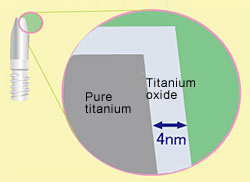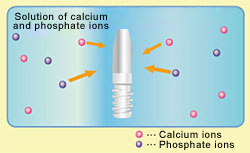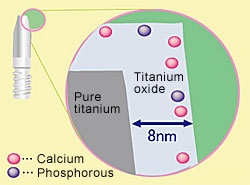HOME > What is the AQB Implant? > Hydrothermal treatment of titanium surface
Dental implants require implant-hard tissue binding to accelerate bone formation as well as a compatibility with the gingival soft tissue in contact with the implants. The AQB Implant provides superior implant-hard tissue binding and has a compatibility with gingival soft tissue because the calcium and phosphorous in the surface layer provides an excellent gingiva-implant connection that creates an adequate seal along the margins very quickly.
 Ca elutes into the body to enhance adhesion of the implant to peripheral tissue.
Ca elutes into the body to enhance adhesion of the implant to peripheral tissue.
Ca in the oxidizing layer also enhances adhesion of the HA coating layer to pure titanium as the base material.
- Hydrothermal treatment
Hydrothermal treatment produces a phosphorous-calcium layer on the surface of titanium oxide that provides rapid adhesion and binding between the titanium surface and gingiva (marginal seal).


Calcium and phosphorous in the surface layer provide an enhanced gingiva-implant connection.
 Ca elutes into the body to enhance adhesion of the implant to peripheral tissue.
Ca elutes into the body to enhance adhesion of the implant to peripheral tissue.Ca in the oxidizing layer also enhances adhesion of the HA coating layer to pure titanium as the base material.
- Hydrothermal treatment
Hydrothermal treatment produces a phosphorous-calcium layer on the surface of titanium oxide that provides rapid adhesion and binding between the titanium surface and gingiva (marginal seal).
Phosphorous-calcium layer on the titanium surface
Hydrothermal treatment
Because of the hydrothermal treatment, calcium and phosphorous are on the surface of the AQB Implant to create a greater seal along the margin between the implant and gingiva.
 1. Pre-treatment 1. Pre-treatmentIn general, a very thin (4 nm) oxidized film covers the surface of the titanium. |
 2. Hydrothermal treatment 2. Hydrothermal treatmentImmerse the AQB Implant in a solution containing calcium and phosphate ions. The titanium oxidizes during the hydrothermal treatment, while calcium and phosphate ions intrude and diffuse onto the titanium surface. |
 3. Post-treatment 3. Post-treatmentHydrothermal treatment thickens the layer of titanium oxide when the oxide film takes in phosphorous and calcium ions to influence the compatibility. - The thickness of titanium oxide increases due to the hydrothermal treatment (4-8 nm). |


